![]()
![]()
![]()
Use LEFT and RIGHT arrow keys to navigate between flashcards;
Use UP and DOWN arrow keys to flip the card;
H to show hint;
A reads text to speech;
24 Cards in this Set
- Front
- Back
|
Australian Snakes
|
~160 spp in 7 families
Typhlopidae (blind snakes) 31spp 1 genera, Rhamphotyphlops Boidae (pythons) 15 spp 5 genera Elapidae (front fanged- venemous) 83 spp 8 genera Colubridae (no fang, nor rear-fanged) 9sp 8 genera Three Families of SEA SNKES Hydrophiidae 13spp, 12 genera Laticaudidae (sea kraits) 2spp 1 genus Laticauda Acrochordidae (file snakes) 2 spp, 1 genera, Acrochordus Typhlopidae and Hydrophiidae are most diverse in australia than anywhere else |
|
|
Types of fangs
|

no hinged front fanged spp
rear fanged, all australian colubrid spp no fangs, pythons |
|
|
Family Typhlopidae
|
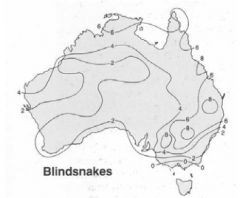
*Blind snakes
Center of diversity in OZ- from here? Small Worm like non venomous subterranean burrowers reduced eyes- small spots under scales Scales-smooth, polished, thick--> protection from ant stings short tail w/tiny spine, anchor when moving in tunnels Eat-ant/termite larvae and eggs, some eat soil dwelling inverts Smell bad @ anal glands when threatened Oviparous |
|
|
Small headed blind snake
|
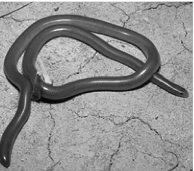
Ramphotyphlops affinis
Grows to 15cm in E australia (not in victoria) |
|
|
Rotund blind snake
|
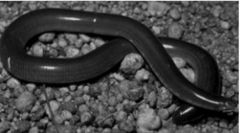
Ramphotyphlops pinguis
Grows to 35 cm small disbn' in southern australia |
|
|
Family Boidae
|
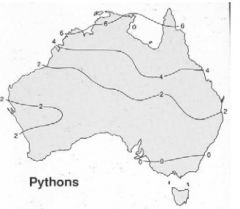
PYTHONS
*Widespread group in tropical and semi-tropical areas Sub families Boinae (boas) and Pythoninae (pythons) only pythons in OZ -oz origion? entered via asia ~25mya 15spp, 5 genera Medium to large bodied snakes many nocturnal Predatorts of other verts- mammals and birds detected by heat sensitive pabrial pits in head Kill by constriction Oviparous, females brood eggs when temp decreases below ~28C brooding females "shiver" to increase heat production for eggs |
|
|
Woma
|

Aspidites ramsayi
Nocturnal Terrestrial Arid regions Preys on small mammals and reptiles Grows to 200cm |
|
|
Green Python
|
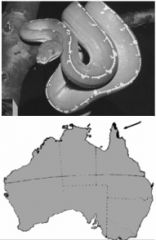
Nocturnal
Arboreal Specialized to capture roosting birds as they sleep @night Tropical rainforest inhab from N QLD Juviniles-bright yellow/orange Grows to 180 cm |
|
|
Carpet or Diamond python
|
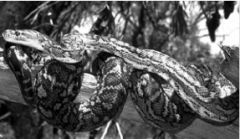
Morelia spilota
Australia's most common python Mostly nocturnal Terrestrial and arboreal Preys on mammals, birds and lizards Grows to 250 cm |
|
|
Family Colubridae
|
Colubrids
Dominant snake in all continents except australia Invaded ~10mya via asia 11spp in 8genera (in oz) 2 subfamilies both venomous, rear-fanged spp envenomation by chewing not injection Usually kill by constriction, venom aids in digesiton Aquatic or tree |
|
|
Subfamily Colubridae
|
*common tree snake, brown tree snake and freshwater snake
*all oviparous |
|
|
Brown Tree Snake
|
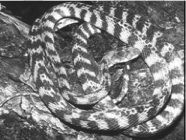
Also found in papua new guinea and indonesia
Mainly nocturnal Preys on small mammals, birds and their eggs and lizards Introduced to Guam and destroyed the bird and lizard fauna there Grows to 200cm |
|
|
Sub Family Homalopsinae
|
Water inhabiting
VIVIPAROUS |
|
|
White bellied mangrove snake
|
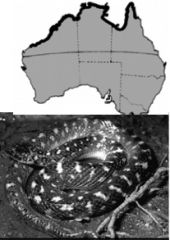
Fordonia leucobalia
Inhabits estuarine areas Eats crabs Holds crabs in coils and bites off legs and crawls with mouth before swallowing- rare b/c snakes usually swallow prey intact Grows to 60cm |
|
|
Family Acrochordidae
|
File snakes
3spp in world Genus Acrochordus 2spp in OZ- OZ origin? AQUATIC (All) A. granulatusin marine and estuarine areas of N Australia and Indo-Pacific A. arafuraeis found in freshwater swamps of N Australia. Scales-sharp pints on them Eat-fish -> rapid strike action, wrap body around and hold w/ pointed scales, swallowed whole head first Non venomous VIVIPAROUS |
|
|
Arafura file snake
|
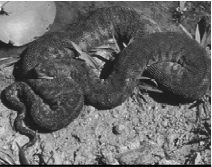
Freshwater swamps, wet-dry tropics in rivers of Papua New Quinea
Skin loose on body Grows to 150 cm |
|
|
Little File snake
|
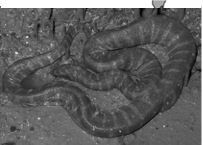
Acrochordus granulatus
-Estuarine mangrove areas well developed salt gland to get rid of salt In papua new guinea and SE asia Grows to 120 cm |
|
|
Family Elapidae
|
Elapids
Diverse/widespread in Africa Asia Australia and Americas- tropical and temperate Greatest div in OZ origion from asia ~25mya Venom glands in oral cavity- pair of short hollow fangs in front of mouth, Venom-prey immobilizing/killing neurotoxins may have myotoxic coagulant/anticoagulant effects SOME OF THE WORLDS MOST VENOMOUS DEADLY SNAKES Eat- mainly vertebrate prey Oviparous and viviparous spp viviparous in colder areas |
|
|
Bandy-bandy
|
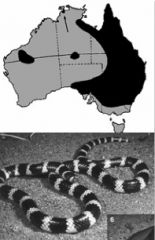
Vermicela annulata
Nocturnal Burrowing Eats blind snakes Oviparous Grows to 50cm |
|
|
Fierce snake (Western taipan)
|
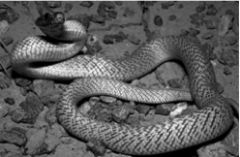
Oxyuranus microlepidotus
AUSTRALIA'S DEADLIEST SNAKE! Feeds on long haired rats Oviparous 200cm Most toxic venom of any snake in the world Fast Good vision Not as aggressive as taipan O. scutellatus |
|
|
Eastern Tiger Snake
|

Prefers swamps and stream areas
Common in suburban areas Highly neurotoxic venom, small fangs Dinurally active Eats- frogs, also lizards, small mammals and birds Viviparous, 10-15 babies Agresssive if cournered Grows to 150 cm |
|
|
Family Hydrophiidae
|
True sea snakes
Closely related to elapid snakes 50spp worldwide- tropic and subtropical waters 31 in OZ 15 endemic to OZ Venomous Front-fanged snakes Fish predators, some specialise on fish eggs (lost fangs and venom system) |
|
|
Family Laticaudidae
|
Sea Kraits
Closely related to sea snakes and elapids. Tropical waters of western Pacific and eastern India oceans and feed on fish Venomous- front fanges Nocturnal, eat fish when they are sleeping Partly terrestrial Oviparous and lay eggs in rock crevices on the sea shore |
|
|
Yellow Bellied Sea Snake
|
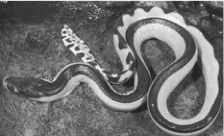
Cosmopolitan disbn
Pelagic fish feeder |

